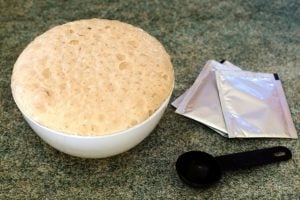Pitching Yeast: The Best Practices To Brew Your Perfect Beer
 Pitching yeast might sound like a hefty technical step in the beer-making process. Don’t get weighed down by the terminology. In layman lingo, it just means adding yeast to the wort — the liquid extracted from the grain for making beer.
Pitching yeast might sound like a hefty technical step in the beer-making process. Don’t get weighed down by the terminology. In layman lingo, it just means adding yeast to the wort — the liquid extracted from the grain for making beer.
Why do we call it pitching?
Because it is like throwing yeast into the wort, like throwing a cricket ball toward a batsman, only gently.
What Is Pitching Yeast? Learn From the Experts.
Yeast is a beguiling organism that helps produce aromatic yet complex flavors, acting as a catalyst in the beer-making process. The enzymes in yeast help break down the sugar in the grain that is used to produce beer. In order to learn how to use it properly for creating the best brew, read ahead.
Pitching Dry Yeast: Is This the Best Practice?
Using dry yeast for brewing is one of the many pointers some recipes might suggest. But our experts would like to strongly disagree. It isn’t considered the best practice to introduce dry yeast into chilled wort. The action may kickstart the fermentation process, but it may also produce some non-appealing and uncomfortable aromas.
So, it is best to rehydrate yeast before pitching it into the wort. This way, you would not only kick off the fermentation process correctly but also get the right flavors and aromas needed for your beer.
Did you know that dry yeast has a longer shelf life than liquid yeast and is easy to store? On the other hand, liquid yeasts need to stay in the refrigerator so as not to go bad. Maybe this explains why some brewers prefer to pitch dry yeast!
How To Pitch Yeast: Experts Recommend This
 If you are a first-time homebrewer, pitching yeast might sound a tad bit ambiguous. Don’t worry, the process is easier than you might think, and you just want to keep the quantity of yeast under control.
If you are a first-time homebrewer, pitching yeast might sound a tad bit ambiguous. Don’t worry, the process is easier than you might think, and you just want to keep the quantity of yeast under control.
If you want to pitch dry yeast, all you have to do is sprinkle the necessary amount on the liquid. This is the easiest way to pitch yeast. But if you are using liquid yeast, you tip it straight in without a second thought.
Of course, this is the simplest process as possible, with no fancy variations of techniques. While in most situations, this would work enough and generate decent aromas, there are plenty who follow multiple processes and methods when pitching yeast for a more complex taste.
Common Questions About Pitching Yeast
In this section, you will find all the common questions that are usually asked about the correct way to pitch yeast. Read on to learn about the best practices from our experts!
– Should You Stir the Yeast Into the Liquid?
For starters, no, you do not need to stir the yeast. Especially when working with dry yeast, one can get carried away and want to stir into the reaction, so that dry yeast tends to bubble up once added to the liquid. Sometimes it may even foam up. But that is not a good idea.
According to expert brewers, it is best practice to leave the yeast be. Dry yeast takes a couple of moments to re-hydrate. So, you can activate the process of rehydrating yeast in your brew itself. This act of pitching smoothens the fermentation process and the whole container mixes alone without the need for stirring. Now, had you stirred the mixture, the yeast would cluster up and the process would have just died.
– What Is the Ideal Temperature To Pitch Yeast?
If you’ve just boiled your brew, you are going to need to wait for it to cool down. Now, the cooling process can be a bit intimidating, because the yeast won’t do its job if it’s pitched at the wrong temperature. That said, it won’t allow fermentation to happen at extremely hot or cold temperatures. This is why you’d need a temperature gauge to keep track of measurements.
It also depends on what you’re brewing. Is it Ale or Lager? For Ale, the ideal yeast pitching temperature is around 68 F to 73 F. Whereas, for Lager, the ideal temperature is considered to be somewhere between 45 F and 55 F.
Most beer kits have these temperatures mentioned on them. Grab one and check it out. That said, if you end up pitching at slightly different temperatures, your beer might still ferment, just not the way you had wished. It would taste different too.
– Best Wort Chillers Out There?
 Ask any religious brewmaster: The key to producing a good beer is the fermentation process. This only occurs once the wort cools down to the desired temperature. It is best to invest in a good quality wort chiller or cooler. This will significantly improve the quality of your beer.
Ask any religious brewmaster: The key to producing a good beer is the fermentation process. This only occurs once the wort cools down to the desired temperature. It is best to invest in a good quality wort chiller or cooler. This will significantly improve the quality of your beer.
The faster the wort cools down, the clearer your beer will be. There are two major types of chillers in the market: Immersion Chillers and Counterflow Chillers. Immersion chillers work by running cold water through their coil. It is an easy and simple process. Counterflow chillers work the other way around. Cold water runs on the outside of the chiller and the hot wort is drained within.
That said, these are some of the best chillers in the market:
- Exchilerator Counterflow Wort Chiller – Approximately $220
- NY Brew Supply Copper Wort Chiller – $105
- Northern Brewer Copperhead Immersion Wort Chiller – $70
– Is Rehydrating Yeast Important?
Honestly, it’s subjective. If you have prepared a high gravity wort, you might want to rehydrate your yeast before pitching it. Simply boil some water, let it cool down in a small container and then add the yeast and watch it dissolve completely. Cover it with a lid to avoid too much air getting in. This should technically be done close to when you are ready to pitch the yeast.
Rehydrating yeast produces the smell of making bread. If this process doesn’t yield bread-making aromas, it is probably a sign that your yeast has dried up, is too old, or is damaged by external factors.
– What Is the Process of Rehydrating Yeast?
Rehydrating yeast only takes about 15 – 20 minutes. It is the simple process of combining water with dry yeast to wake its properties for a smoother fermentation process. Most packets of dry yeast come with instructions, but if yours doesn’t have one, check these steps out:
- In a clean container, take some sterile water at room temperature. Calculate 1 fluid ounce of water per every ounce of yeast
- Get the dry yeast to room temperature.
- Add the dry yeast to the water container and cover it with a lid. Let it sit for 15 minutes.
- Slowly adjust the temperature of the yeast closer to the wort temperature.
- Pitch the creamy mixture in the container to the wort as soon as possible.
– How Much Is Too Much?
This depends on the amount of alcohol you want your beer to contain. If you are producing beer with a very high alcohol content, you might want to pitch two packets of yeast to your wort. Also, you may want to use two packets if your yeast has touched old-age. As a matter of fact, older yeast catalyzes slower.
Also, Ale may ferment with just a packet of yeast. On the other hand, Lager needs a lower temperature for pitching, which may require two packets of yeast.
– What Are the Best Types of Yeasts Out There?
When you are a homebrewer, the whole game rests on the yeast. The type of yeast strain helps develop the exact taste of the beer. These are some of the famous types of yeasts against the type of flavor they produce:
- American ale yeast – Everything extra. This yeast delivers a beer that is clean, crunchy, and versatile.
- Belgian yeast – The high alcohol beer. Just imagine sipping on strong dark Belgian ale, you know the taste, aye? This yeast strain can survive a high alcohol environment.
- German ale yeast – It’s all about the zest. I will just say one word: German wheat beers. You get it, right?
- American lager yeast – Crisp and dry. This yeast strain creates a dryer environment making up for a ship-shaped flavor.
Conclusion
We have covered a lot about pitching yeast. From the right amounts to the precise temperatures. All this information can be a little overwhelming. Let’s sum it up for you to make sure you are ready to Pitch your yeast and produce your perfectly exquisite beer:
 Pitching yeast is adding yeast to the wort
Pitching yeast is adding yeast to the wort- Pitching dry yeast is not considered best practice
- Always rehydrate your dry yeast. It will only yield better results
- With dry yeast, you sprinkle the packet into the wort or rehydrate it
- With liquid yeast, tip it straight into the wort
- The older the yeast, the more you need it in quantity
- The ideal temperature to pitch yeast in Ale is around 68 F to 73 F. For Lager, the ideal temperature is somewhere between 45 F and 55 F.
- Invest in a good chiller. Quality is everything.
The yeast pitching process may seem overwhelming for first-time homebrewers, but with some practice, anyone can master it. Just pick what aromas and flavors you want your beer to contain and pitch the right yeast at the right temperature and bam – you’ve got your finished product.

 Pitching yeast is adding yeast to the wort
Pitching yeast is adding yeast to the wort




